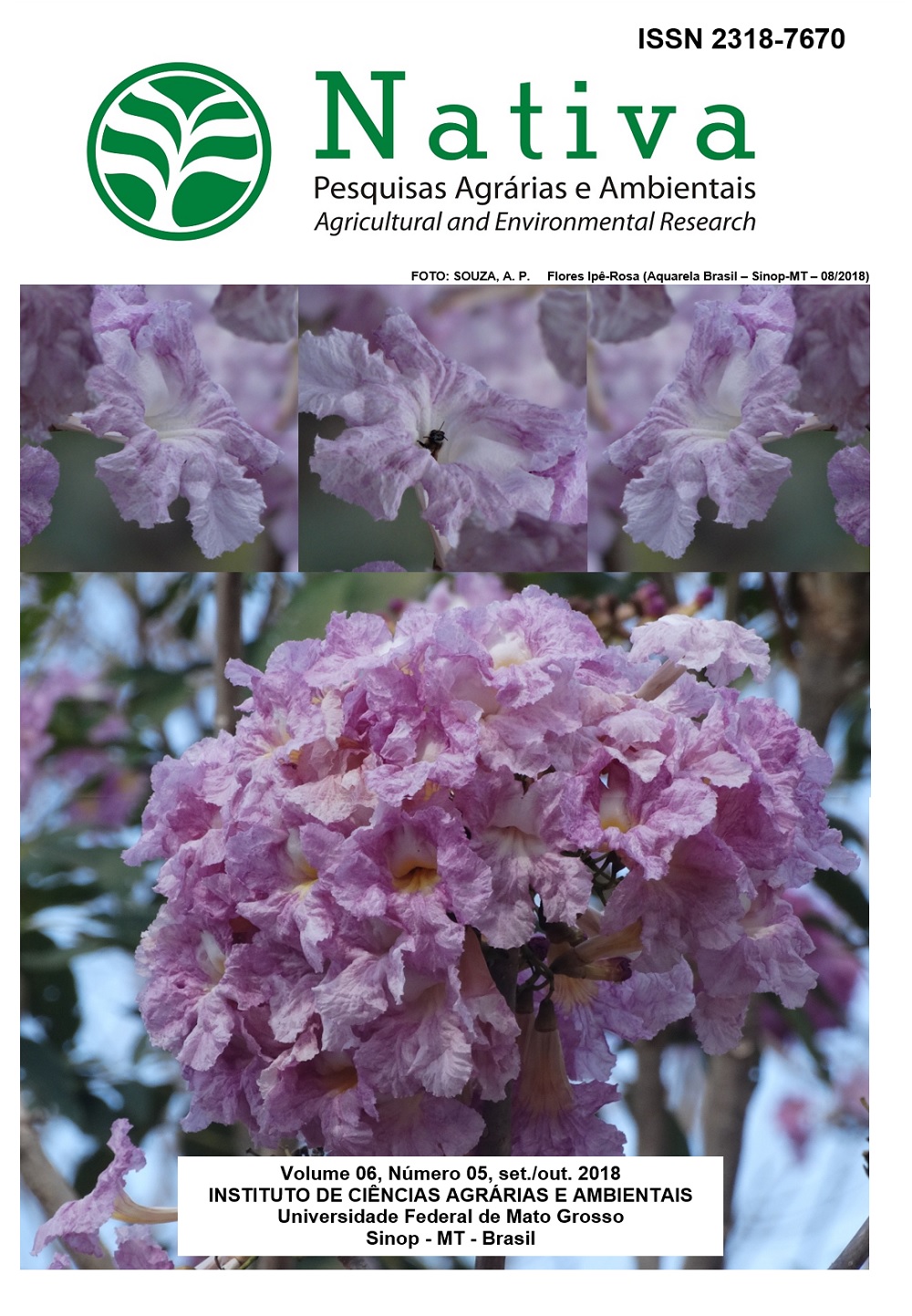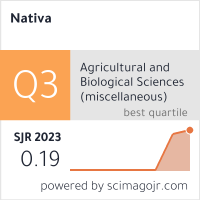COMPOSIÇÃO FLORÍSTICA, DIVERSIDADE E ESTRUTURA DA VEGETAÇÃO ARBÓREO-ARBUSTIVA DE CAATINGA SOB SISTEMAS SILVICULTURAIS
DOI:
https://doi.org/10.31413/nativa.v6i5.5971Resumo
O presente artigo visou investigar a composição florística, diversidade e parâmetros estruturais proporcionados por quatro sistemas silviculturais à vegetação arbóreo-arbustiva de Caatinga em dois locais contíguos. Um deles está localizado na Estação Ecológica do Seridó (EES); o outro na Fazenda Pedro Cândido (FPC); os dois situados em Serra Negra do Norte-RN. Os sistemas silviculturais foram: corte raso; corte seletivo (diâmetro na base – DNB > 8 cm); corte raso com queima dos resíduos da colheita; corte raso com queima dos resíduos da colheita e destoca do caule. Mediu-se em cada área 16 parcelas, com inclusão de indivíduos com CAP>6 cm. Determinou-se: composição florística, riqueza de espécies, diversidade, densidade de fustes, dominância absoluta, IP e IMA (1989-2016). Comparou-se a diversidade (J’) pelo teste de Tukey (P < 0,05). A riqueza de espécies apresentou condições semelhantes às da época da instalação do experimento. A grande abundância de algumas espécies contribuiu para a redução da diversidade medida pelo Índice de Shannon-Weaver, em relação a 1989. Os incrementos proporcionados pelos sistemas silviculturais variaram conforme a área, com tendência de redução do ritmo de crescimento em ambas. O tempo de regeneração (27 anos) não foi suficiente para a restauração integral da dominância absoluta.
Palavras-chave: estrutura florestal, restauração florestal, regeneração natural, semiárido.
FLORISTIC COMPOSITION, DIVERSITY AND STRUCTURE OF SHRUB-ARBOREAL VEGETATION OF CAATINGA UNDER SILVICULTURAL SYSTEMS
ABSTRACT:
This work aimed to investigate the floristic composition, the diversity and structural parameters provided by four silvicultural systems to arboreal-shrub vegetation in two areas Caatinga. The first area is in the Seridó Ecological Station (SES) and the second is on Pedro Cândido Farm (PCF), in the county of Serra Negra do Norte-RN. The silvicultural systems used were: general cut; selective cut of individuals with base circumference > 8 cm; general cut of all individuals and subsequent burning of crop residues; general cut with subsequent burning of crop residues and removal of stem from soil. It was determined: floristic composition, species richness, diversity, density of stems, absolute dominance, periodic increase and average annual increment (1989-2016). The diversity (J ') was compared by Tukey's test (P < 0,05). The species richness presented conditions similar to those at the time of the installation of the experiment. The greater abundance of some species contributed to the reduction of diversity measured by the Shannon-Weaver Index, in relation to 1989. The increases provided by silvicultural systems varied according to the area, with tendency to reduce of rate the growth in both. The regeneration time (27 years) was not sufficient for the complete restoration of absolute dominance.
Keywords: forestry structure, forest restoration, natural regeneration, semiarid.
Referências
AMORIM, I. L.; SAMPAIO, E. V. S. B.; ARAÚJO, E. L. Flora e estrutura da vegetação arbustivo-arbórea de uma área de caatinga do Seridó, RN, Brasil. Acta Botanica Brasilica, Belo Horizonte, v. 19, n. 3, p. 615-623, 2005. Disponível em: <http://www.scielo.br/pdf/abb/v19n3/27377.pdf> Acesso em: 05 de Nov de 2013
ANDRADE, L. A.; OLIVEIRA, F. X.; NEVES, C. M. L.; FELIX, L. P. Análise da vegetação sucessional em campos abandonados no agreste paraibano. Revista Brasileira de Ciências Agrárias, Recife, v. 2, n. 2, p. 135-142, 2007. Disponível em: <http://www.agraria.pro.br/sistema/index.php?journal=agraria&page=article&op=view&path%5B%5D=174&path%5B%5D=81> Acesso em: 12 de Out 2013.
ARAÚJO, L. V. C.; SILVA, J. A. Unidade experimental estação ecológica do Seridó-RN. In: GARIGLIO, et al. Uso sustentável e conservação dos Recursos Florestais da Caatinga. Brasília: Serviço Florestal Brasileiro, 2010. Disponível em: <http://www.mma.gov.br/estruturas/sfb/_arquivos/web_uso_sustentvel_e_conservao_dos_recursos_florestais_da_caatinga_95.pdf> Acesso em: 19 de Mar de 2014.
BROWER, J. E.; ZAR, J. H. Field and laboratory methods for general ecology. 2. ed. Dubuque: Wm, C. Brown Publishers, 1984. 226 p.
CALIXTO JÚNIOR, J. T.; DRUMOND, M. A. Estrutura Fitossociológica de um fragmento de Caatinga Sensu Stricto 30 anos após corte raso, Petrolina-PE, Brasil. Revista Caatinga, Mossoró, v. 24, n. 2, p. 67-74, 2011. Disponível em: < http://periodicos.ufersa.edu.br/revistas/index.php/sistema/article/view/1917/4714> Acesso em: 14 de Abril de 2014.
CECCON, E.; HUANTE, P.; RINCÓN, E. Abiotic Factors influencing tropical dry forests regeneration. Brazilian Archives of Biology and Technology, Curitiba, v. 49, n. 2, p. 305-312, 2006. DOI: http://dx.doi.org/10.1590/S1516-89132006000300016
CHAZDON, R. Regeneração de florestas tropicais. Revista Ciências Naturais, Belém, v. 7, n. 3, p. 195-218, 2012. Disponível em: <http://www.museugoeldi.br/editora/bn/artigos/cnv7n3_2012/regeneracao(chazdon).pdf> Acesso em: 28 de Jan de 2014.
COSTA, T. C. C.; OLIVEIRA, M. A. J.; ACCIOLY, L. J. O.; SILVA, F. H. B. B. Análise da degradação da Caatinga no núcleo de desertificação do Seridó (RN/PB). Revista Brasileira de Engenharia Agrícola e Ambiental. Campina Grande, v. 13, p. 961-974, 2009. Disponível em: <http://www.scielo.br/pdf/rbeaa/v13s0/v13s0a20.pdf> Acesso em: 03 de Out de 2013.
EMBRAPA – EMPRESA BRASILEIRA DE PESQUISA AGROPECUÁRIA . Manual de métodos de análise de solos. Rio de Janeiro: Centro Nacional de Pesquisa de Solos, 1997. 212p. <http://www.agencia.cnptia.embrapa.br/Repositorio/Manual+de+Metodos_000fzvhotqk02wx5ok0q43a0ram31wtr.pdf> Acesso em: 09 de Mai de 2015.
EMBRAPA – EMPRESA BRASILEIRA DE PESQUISA AGROPECUÁRIA. Sistema brasileiro de classificação de solos. 3. ed. Brasília: Embrapa, 2013. 353p.
FABRICANTE, J. R.; ANDRADE, L. A. Análise estrutural de um remanescente de Caatinga no Seridó Paraibano. Oecologia brasiliensis, Rio de Janeiro, v. 11, n.3 , p. 341-349, 2007. Disponível em: <http://www.ppgecologia.biologia.ufrj.br/oecologia/index.php/oecologiabrasiliensis/article/view/149/115> Acesso em: 19 de Dez de 2013.
FERRAZ, J. S. F.; FERREIRA, R. L. C.; SILVA, J. A. A.; MEUNIER, I. M. J.; SANTOS, M. V. F. Estrutura do componente arbustivo-arbóreo da vegetação em duas áreas de Caatinga, no município de Floresta-PE. Revista Árvore, Viçosa, v. 38, n. 6, p. 1055-1064, 2014. DOI: http://dx.doi.org/10.1590/S0100-67622014000600010.
FLORA DO BRASIL. (2017). Lista de espécies da Flora do Brasil. Jardim Botânico do Rio de Janeiro. Disponível em: http://floradobrasil.jbrj.gov.br/
GRISCOM, H. P.; ASHTON, M. S. Restoration of dry tropical forests in Central America: A review of pattern and process. Forest Ecology and Management, v. 226, n. 10, p. 1564-1579, 2011. DOI: https://doi.org/10.1016/j.foreco.2010.08.027
HOLANDA, A. C.; LIMA, F. T. D.; SILVA, B. M.; DOURADO, R. G.; ALVES, A. R. Estrutura da vegetação em remanescente de Caatinga com diferentes históricos de perturbação em Cajazerinhas (PB). Revista Caatinga, Mossoró, v. 28, n. 4, p. 142-150, 2015. DOI: http://dx.doi.org/10.1590/1983-21252015v28n416rc
IBGE – INSTITUTO BRASILEIRO DE GEOGRAFIA E ESTATÍSTICA. Produção da Extração Vegetal e da Silvicultura – ano 2016. Rio de Janeiro, 2017. Disponível em: < https://sidra.ibge.gov.br/tabela/289#resultado> Acesso em: 15 de Mai. de 2017.
KENNARD, D. K.; GOULD, K.; PUTZ, F. E.; FREDERICKSEN, T. S.; MORALES, F. Effect of disturbance intensity on regeneration mechanisms in a tropical dry forest. Forest ecology and Management, Amsterdam, v. 162, p. 197–208, 2002. Disponível em: DOI: https://doi.org/10.1016/S0378-1127(01)00506-0 Acesso em: 05 de Mai de 2015.
KÖPPEN, W. Tradução: CORRÊA, A. C. B. Sistema Geográfico dos Climas. Notas e Comunicado de Geografia - Série B: Textos Didáticos n° 13. Editora Universitária - UFPE, Departamento de Ciências Geográficas, UFPE, p.31, 1996.
LUCENA, M. S.; SILVA, J. A.; ALVES, A. R. Regeneração natural do estrato arbustivo-arbóreo em área de Caatinga na Estação Ecológica do Seridó – RN, Brasil. Revista Biotemas, Florianópolis, v. 29, n. 2, p. 17-31, 2016. DOI: http://dx.doi.org/10.5007/2175-7925.2016v29n2p17 Acesso em: 11 de Mai. de 2016
MARANGON, G. P.; FERREIRA, R. L. C.; SILVA, J. A.; LIRA, D. F. S.; SILVA, E. A.; LOUREIRO, G. H. Estrutura e padrão espacial da vegetação em uma área de Caatinga. Floresta, Curitiba, v. 43, n. 1, p.83-92, 2013. DOI: http://dx.doi.org/10.5380/rf.v43i1.27807 Acesso em: 09 de Dez. de 2016
MATTOS, P. P.; BRAZ, E. M.; DOMENE, V. D.; SAMPAIO, E. V. S.; GASSON, PETER.; PAREYN, F. G. C.; ALVAREZ, I. A.; BARACAT, A.; ARAÚJO, E. L. Climate-tree growth relationships of Mimosa tenuiflora in seasonally dry tropical forest, Brazil. Cerne, v.21, n.1, p.141-149, 2015. DOI: http://dx.doi.org/10.1590/01047760201521011460 Acesso em: 23 de Jan. de 2018
MEUNIER, I. M. J.; CARVALHO, J. E. Crescimento da caatinga submetida a diferentes tipos de corte, na Região do Seridó do Rio Grande do Norte. Natal: Projeto MMA/FAO/UTF/BRA/047, 2000. 28 p. (Boletim Técnico; n.4).
MUELLER-DAMBOIS, D.; ELLEMBERG, H. Aims and methods of vegetation ecology. New York: Jonh Willey y Sons, 1974. 547p.
QUESADA, M.; SANCHEZ-AZOFEIFA, G. A.; ALVAREZ-ANORVE, M.; STONER, K. E.; AVILA-CABADILLA, L.; CALVO-ALVARADO, J.; CASTILLO, A.; ESPÍRITO-SANTO, M. M.; FAGUNDES, M.; FERNANDES, G. W.; GAMON, J.; LOPEZARAIZA-MIKEL, M.; LAWRENCE, D. MORELATO, L. P. C.; POWERS, J. S.; NEVES, F. S.; ROSAS-GEURRERO, V.; SAYAGO, R.; SANCHEZ-MONTOYA, G. Sucession and manegement of tropical dry forest in the Americas: Review and new perspectives. Forest Ecology and Management, Amsterdam, v. 258, n .6, p. 1014-1024, 2009. DOI: http://dx.doi.org/10.1016/j.foreco.2009.06.023
RMFC – REDE DE MANEJO FLORESTAL DA CAATINGA. Protocolo de Medições de Parcelas Permanentes. Recife: Associação de Plantas do Nordeste; Brasília: MMA, PNF, PNE, 2005. 30p. Disponível em: <http://www.cnpf.embrapa.br/pesquisa/sispp/protocolo_RMFC.pdf> Acesso em: 27 de Nov. de 2013.
SAMPAIO, E. V. S. B.; ARAÚJO, E. L.; SALCEDO, I. H.; TIESSEN, H. Regeneração da vegetação de caatinga após corte e queima, em Serra Talhada, PE. Revista Pesquisa Agropecuária Brasileira, Brasília, v. 33, n. 5, p. 621-632, 1998. Disponível em: <http://seer.sct.embrapa.br/index.php/pab/article/view/4890/7006> Acesso em: 03 de Out de 2013.
SANTANA, J. A. S.; SOUTO, J. S. Diversidade e Estrutura Fitossociológica da Caatinga na Estação Ecológica do Seridó-RN. Revista de Biologia e Ciências da Terra, São Cristóvão, v. 6, n. 2, p. 232-242, 2006. Disponível em: <http://eduep.uepb.edu.br/rbct/sumarios/pdf/serido.pdf> Acesso em: 03 de Out. de 2013.
SANTANA, J. A. S.; VIEIRA, F. A.; PACHECO, M. V.; OLIVEIRA, P. R. S. Padrão de distribuição e estrutura diamétrica de Caesalpinia pyramidalis Tul. (Catingueira) na Caatinga do Seridó. Revista de Biologia e Ciências da Terra, São Cristóvão, v. 11, n. 1, 2011. Disponível em: < http://www.redalyc.org/pdf/500/50021097012.pdf.> Acesso em: 28 de Dez. de 2016.
SOUZA, A. L.; SOARES, C. P. B. Florestas Nativas: estrutura, dinâmica e manejo. Viçosa- MG: Ed. UFV, 2013. 322 p.
VELAZCO, S. J. E.; GALVÃO, F. KELLER, H. A.; BEDRIJ, N. A. Florística e fitossociologia de uma floresta estacional semidecidual, reserva privada Osununú-Misiones, Argentina. Floresta e Ambiente, v. 22, n. 1, p. 1-12, 2015. DOI: http://dx.doi.org/10.1590/2179-8087.038513 Acesso em: 23 de Jan. de 2018
Downloads
Publicado
Edição
Seção
Como Citar
Licença
Direitos Autorais para artigos publicados nesta revista são do autor, com direitos de primeira publicação para a revista. Em virtude de a aparecerem nesta revista de acesso público, os artigos são de uso gratuito, com atribuições próprias, em aplicações educacionais e não-comerciais.
A artigos publicados nessa revista, podem ser reproduzidos parcialmente ou utilizados como referência por outros autores, desde que seja cita a fonte, ou seja, a Revista Nativa.
Copyright for articles published in this journal are the authors, with first publication rights granted to the journal. The journal shows open access, and articles are free to use, with proper attribution, in educational and non-commercial.
The articles published in this journal may be reproduced in part or used as a reference by other authors, provided that the source is quoted.






